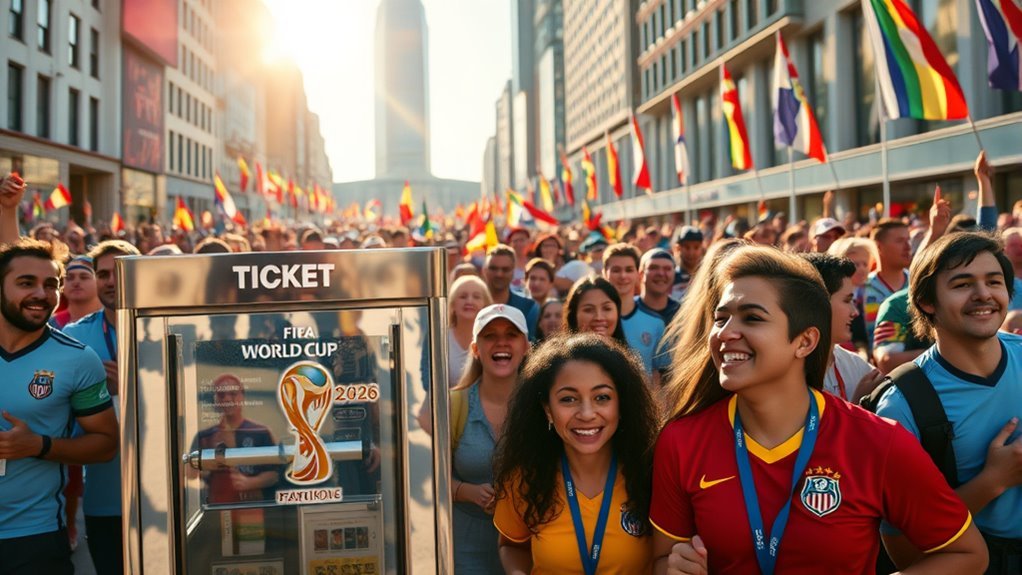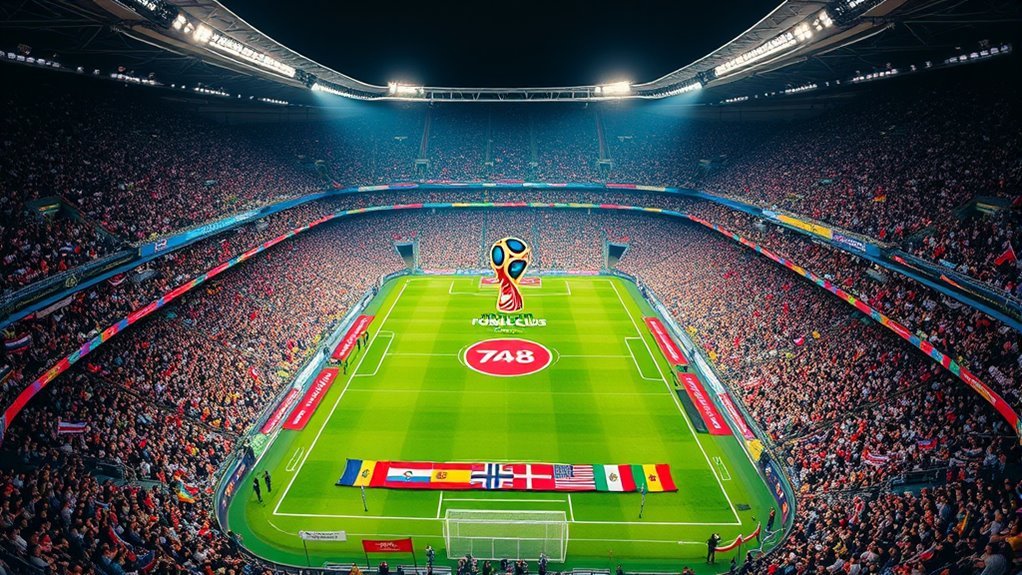As of now, no teams have officially qualified for the FIFA World Cup 2026. This tournament marks a historic expansion to 48 teams, which promises a more inclusive and competitive experience. The automatic spots will be allocated to the host countries: the United States, Canada, and Mexico. With regional qualifiers looming, the excitement for which teams will make it is building. There’s a lot more happening with this tournament that you’ll want to know about!
Overview of the Expanded Format
As you might know, the FIFA World Cup 2026 will feature an expanded format that considerably alters the tournament’s landscape. Instead of the traditional 32 teams, the competition will now include 48 teams, offering expanded opportunities for nations to showcase their talent on the world stage. This change isn’t just about numbers; it’s about embracing global representation.
More countries can now participate, allowing fans from diverse backgrounds to unite in their love for the game. Imagine the thrill of seeing teams from regions that previously struggled to qualify, now competing among the best. This format promotes inclusivity and gives underrepresented nations a chance to shine.
Qualification Process for the 2026 World Cup
As the 2026 World Cup approaches, you’ll notice some significant changes in the qualification format. With an expanded number of teams, the regional allocation is also shifting to accommodate more nations. Let’s explore how these adjustments will impact the road to the tournament.
Qualification Format Changes
With the 2026 FIFA World Cup on the horizon, fans and players alike are enthusiastic to understand the new qualification format. The tournament will expand from 32 to 48 teams, leading to significant qualification criteria changes and tournament structure adjustments. This shift opens the door to more nations, giving everyone a fair shot at glory.
| Round | Teams Participating | Qualification Method |
|---|---|---|
| Preliminary | 180+ | Regional qualifiers |
| Group Stage | 48 | Top teams from qualifiers |
| Knockout | 32 | Elimination matches |
| Final | 1 | Championship match |
| Total | 48 | Combined efforts |
These changes promise a thrilling experience for fans and players, reflecting the spirit of freedom and competition!
Regional Allocation Breakdown
The regional allocation for the 2026 FIFA World Cup reflects a more inclusive approach, granting opportunities to a wider array of nations. This shift in regional dynamics means you can expect diverse qualification strategies, ensuring that teams from various continents can showcase their talent on the global stage.
Here’s a quick breakdown of the allocation:
- North America: Hosts get automatic spots, promoting regional representation.
- Africa: Increased slots allow for more nations to participate, highlighting emerging talent.
- Asia & Oceania: More opportunities for teams to prove themselves, fostering competitive spirit.
This expansion not only opens doors for many but also enriches the tournament, making it a true celebration of global football.
Host Nations and Automatic Qualification
Three nations will host the FIFA World Cup 2026: the United States, Canada, and Mexico. As the tournament approaches, you can feel the excitement in the air, with host nation preparations already underway. Each country is gearing up to showcase their culture and love for the game, making this event truly special.
In this expanded format, the number of automatic qualifiers has also increased, allowing these hosts to secure their spots without the pressure of qualifying matches. The automatic qualifiers analysis reveals how this change not only benefits the hosts but also sets the stage for a thrilling competition.
Fans can look forward to electrifying matches in iconic stadiums across North America, uniting people through the beautiful game. As the world’s attention turns to these host nations, it’s a chance for you to experience the freedom of football like never before.
Regional Qualification Allocations
Now that we’ve covered the host nations and automatic qualifications, let’s look at how regional qualification allocations work. You’ll see how many teams each continent gets to send to the World Cup and how that affects the distribution of qualified teams. Understanding these allocations is key to grasping the tournament’s competitive landscape.
Allocation by Continent
As FIFA prepares for the 2026 World Cup, the allocation of spots among continents reflects a new approach aimed at inclusivity and competitiveness. This shift acknowledges the evolving landscape of global football, emphasizing fair continental representation. You’ll notice some interesting qualification trends that highlight diversity:
- Increased spots for underrepresented regions: This allows more nations to showcase their talent.
- Balancing historical powerhouses with emerging teams: It promotes competitive integrity.
- Encouraging grassroots development: More opportunities can inspire growth in football across all continents.
Qualified Team Distribution
The distribution of qualified teams for the 2026 FIFA World Cup is set to reflect a more equitable approach, with a total of 48 spots available. This change aims to emphasize diversity and inclusivity across regions. You’ll see a significant increase in qualified team statistics, particularly for nations in Africa and Asia, allowing more voices to be heard on the global stage. As you follow the qualification timeline, keep an eye on how these allocations evolve, offering opportunities for both emerging and established teams. It’s about breaking barriers and celebrating football’s universal appeal. So, whether you’re rooting for a powerhouse or an underdog, the 2026 tournament promises to bring exciting matches and fresh narratives.
Teams That Have Secured Their Spots
So far, a handful of teams have secured their spots for the FIFA World Cup 2026, marking a significant step toward this highly anticipated tournament. The excitement is palpable as fans enthusiastically await the clash of qualified teams from around the globe. Here’s what you can look forward to:
A select few teams are already set for FIFA World Cup 2026, heightening anticipation for this thrilling global event.
- Diverse representation: Countries from different continents are making their mark.
- Rising talents: Young players are stepping up, promising thrilling performances.
- Historic rivalries: Classic matchups are on the horizon, reigniting old passions.
As these teams prepare for the tournament, the atmosphere is charged with anticipation. Each qualification adds to the overall tournament excitement, creating a sense of unity among fans. Whether you’re a die-hard follower or a casual observer, the journey to 2026 is bound to be unforgettable. Embrace the spirit of the game, and get ready for a showcase of talent and determination!
Notable Teams to Watch
With several teams already securing their spots for FIFA World Cup 2026, attention now turns to the notable contenders that are expected to shine on the world stage. You’ll want to keep an eye on traditional powerhouses like Brazil and Germany, boasting star players who can change the game in an instant. However, don’t overlook emerging nations like Qatar and Morocco, who’ve been making strides in recent international tournaments. These teams could surprise everyone, showcasing fresh talent and innovative strategies that challenge the status quo.
As the tournament draws closer, the excitement builds around how these teams will perform. Fans are enthusiastic to see how established stars will mesh with rising talents from lesser-known footballing nations. This mix of experience and new energy could lead to unforgettable moments and thrilling matches. So, gear up and get ready for a World Cup filled with passion, rivalry, and unforgettable football!
Impact of the Expanded Format on Competition
As the FIFA World Cup expands to include more teams for 2026, you can expect a significant shift in the competition landscape. This expanded competition offers new opportunities but also challenges for teams aiming for glory. It’s about embracing diversity and ensuring fair play among nations.
- More teams mean a broader talent pool, showcasing emerging football nations.
- Increased matches could lead to unexpected upsets, making the tournament even more thrilling.
- The focus on fair play becomes essential, ensuring that all teams compete on equal footing.
With more nations participating, you’ll see varied styles of play and strategies, enriching the tournament experience. The expanded format not only levels the playing field but also fuels the passion for the game, allowing fans to connect with teams they might not have seen before. This shift promises to redefine what we think of as competition in the World Cup, opening doors for all.
Fan Experience and Attendance Expectations
While the expanded format of the FIFA World Cup 2026 promises a more diverse competition, it also sets the stage for an unparalleled fan experience. With more teams participating, you can expect a vibrant mix of cultures and styles, enhancing your spectator experience. Imagine the electric atmosphere in stadiums filled with passionate fans, all cheering for their countries.
Fan engagement will take center stage as organizers introduce innovative ways to connect you with the action. From interactive apps to immersive viewing zones, there’ll be something for everyone, ensuring you feel part of the excitement. Attendance expectations are sky-high, with millions of fans set to gather in stadiums across North America.
This World Cup isn’t just about the matches; it’s a celebration of football culture. So, gear up for an unforgettable journey, where your voice and presence matter more than ever.
Future Implications for International Football
The expansion of the FIFA World Cup to include more teams will certainly reshape the landscape of international football. You’ll witness a surge in global football representation, allowing nations that often fly under the radar to shine on the world stage. This could lead to exciting international collaborations, fostering unity among different cultures through the beautiful game.
Here are some implications to reflect on:
- Increased Opportunities: More teams mean more chances for underdog nations to compete, bringing fresh talent and perspectives.
- Diverse Narratives: Expect a rich tapestry of stories, as lesser-known teams share their journeys, enhancing the tournament’s overall appeal.
- Economic Growth: Countries participating in the World Cup can experience boosts in tourism and investment, creating a ripple effect for local economies.
Ultimately, this expansion could redefine how you view and engage with international football, making it more inclusive and vibrant.
Frequently Asked Questions
How Does the Expanded Format Affect Previous World Cup Records?
The expanded format can alter tournament dynamics, leading to shifts in historical statistics. You’ll see more teams, potentially impacting records and making it exciting, but it might also dilute some traditional rivalries from past tournaments.
When Will the Final List of Qualified Teams Be Announced?
You’ll find the final announcement of qualified teams comes just months before the tournament. With 48 teams now, imagine the excitement as nations vie for spots during the qualification timeline. Freedom to dream big awaits!
What Are the New Rules for the Qualifying Matches?
The new rules for qualifying matches include updated qualifying criteria and varied match formats. You’ll see more opportunities for teams to showcase their talent, giving everyone a fair shot at the prestigious tournament. Enjoy the competition!
How Will the Expanded Format Influence Ticket Prices?
The expanded format will likely increase ticket demand, leading to a pricing strategy that reflects higher interest. You might find tickets more expensive, but it also means more opportunities to experience thrilling matches live.
Will There Be Any Changes to the World Cup Trophy?
The trophy design might evolve, reflecting its historical significance, much like a phoenix rising anew. You’ll see changes that celebrate the spirit of the game, embodying freedom and unity among nations, while honoring tradition.




